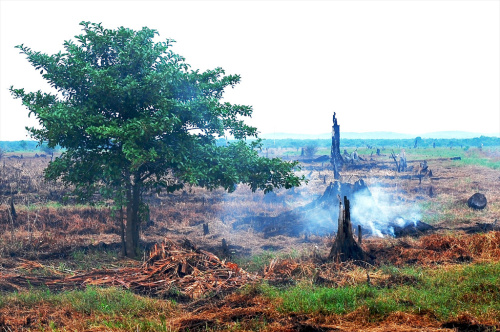Some 40 peatland researchers from 13 countries have pressed for an increase in protections for peatlands, as economic development continues to threaten the integrity of these areas – which are rich in biodiversity and a key resource in efforts to limit climate change.

From the tropical peat swamps in the Congo Basin in the Democratic Republic of Congo (DRC), to the extensive boreal and subarctic bogs and fens of the Hudson Bay Lowland in Canada – the world’s second largest peatland after the West Siberian Lowland in Russia – mining, oil and gas exploration, and other destructive projects carve up the sensitive wetlands, releasing carbon that has been stored in peat for thousands of years and imperiling endangered species.
“Destroying peatlands is among the most obvious ways that humans are undermining the life support systems that enable us to thrive on Earth,” said Dan Zarin, Executive Director for Forests & Climate Change at the Wildlife Conservation Society in a statement released on Thursday, December 1, 2022.
“When the carbon stored in peat is added to the atmosphere, it accelerates the climate crisis that is costing billions of dollars and millions of lives. Protecting rather than degrading these peculiar ecosystems that add up to less than three percent of the land area of the planet is sound economic and security policy. Their degradation prioritises private interests over public benefits,” Zarin added.
Massive Carbon Stores and Wildlife Refuges
Globally, peatlands comprise only 3% of the Earth’s land surface, but they store the equivalent of 70% of the carbon contained in all known coal, oil and gas reserves on the planet, 600 billion tonnes. Research has shown that the carbon absorbed by peatlands over many thousands of years – with some peatlands 40,000 years old – must remain in the ground, undisturbed, if humanity is to avoid the worst impacts of climate change. Peatlands are so critical to climate efforts that many countries with large areas of degraded peatlands, such as across Europe, are seeking to restore them to prevent ongoing emissions and to return them to carbon sinks.
Peatlands are also critical to efforts to protect the world’s biodiversity. Tropical peatlands, for example, are home to 45% of the world’s endangered mammal species and 33% of the world’s endangered birds. The Congo Basin is home to the Western lowland gorilla and the African forest elephant. In Indonesia, the peatlands are home to the orangutan and Sumatran tiger. And peatlands across the boreal provide vast habitat for multiple species, including those at risk of extinction.
For example, the Hudson Bay Lowland in Canada is home to the caribou, polar bear and wolverine, and is a globally important region for migratory birds. When these ecosystems are left intact, they safeguard these species while also providing clean water, flood and fire prevention and source of income to local communities – and beyond.
Canada’s Hudson Bay Lowland and Congo Basin Under Threat
In the statement released on Thursday, scientists sound alarm bells about two current and significant threats to global peatlands conservation. The first is a planned mining area known as the “Ring of Fire” in the world’s second largest peatland, Canada’s Hudson Bay Lowland. The vast, carbon-rich peatland complex sits above deposits of critical minerals. But it is also the homelands of dozens of Indigenous communities that rely on the peatlands for clean water and food – from caribou to fish.
Mines and the roads built to extract these minerals from this region would destroy the peatlands, disrupting the services these landscapes provide to local communities, the country and globally. Mining in the Ring of Fire area could impact an estimated 450 million tonnes of carbon stored in the peatlands.
The second challenge is the DRC government’s decision to open up parts of the Congo Basin peatlands to bids from oil and gas companies – despite protests from environmental advocates and others to preserve them. Sitting atop vast oil reserves, this ecosystem, the Cuvette Centrale, is one of the world’s largest tropical peat carbon stores. Also, home to forest elephants, mountain and lowland gorillas, bonobos and crocodiles, the area is so remote that the peatland carbon stores were only mapped in detail in 2016. Allowing oil and gas exploration to take place in this region would lead to the additional use of fossil fuels at the expense of an ecosystem that would otherwise help absorb the climate pollution fossil fuels emit.
“As recent pledges to protect and restore forests have shown us, world leaders increasingly recognise that protecting rather than destroying the natural world is best for the climate, biodiversity and people,” said Lorna Harris, the lead author of the statement and a forests, peatlands and climate change scientist at Wildlife Conservation Society Canada.
“But with threats bearing down on peatlands across the world, it’s time for decisionmakers at the highest levels to turn their attention to these massive carbon stores and wildlife safe havens – before it’s too late. A first step is to supply the funding necessary to ensure these peatlands remain intact.”
We Must Protect and Restore the World’s Peatlands
The UN Food and Agricultural Organisation (FAO) estimates that up to one quarter of global peatlands have been disturbed or drained, allowing the carbon they contain to be released into the atmosphere. Although drained peatlands cover less than 0.5% of the world’s land surface, they emit roughly 4% of all global greenhouse gas emissions.
The Indonesian government made the restoration of peatlands one of the linchpins of its emissions reduction plan under the Paris Climate Agreement. In its latest report, Indonesia has documented the restoration of 4.8 million hectares of peatlands, with approximately three quarters of these lands located within private sector concession areas like palm oil and timber plantations. Indonesia has also implemented and maintained a moratorium on further peatland conversion.
Given the vast carbon stocks in global peatlands, any plan to mitigate dangerous climate change and its impacts must include their conservation and restoration.
